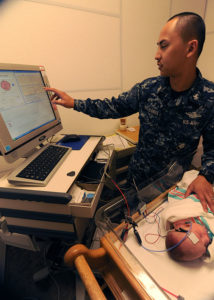
Babies recall speech and music patterns learned in the womb.
Prenatal learning has been measured with infant sucking responses (1988) and brain activity monitoring (EEG) (2012).
Definition: An electroencephalogram (EEG) is a test used to detect abnormalities related to electrical activity of the brain. This procedure tracks and records brain wave patterns. Small metal discs with thin wires (electrodes) are placed on the scalp, and then send signals to a computer to record the results.
Source: EEG defined.
Just as the superb fairy wren studies utilized audiovisual observation in 2012, and in 2014, followed by more in-depth measurements of embryonic responses as seen on a noninvasive heart rate monitor, a similar progression of methods have been utilized in studying human babies.
In November, 2012, a neuroscientist in Helsinki, Finland, Eino Partanen, measured electrical activity in infants brains, to assess familiarity of newborns with audio stimuli after known exposures in the womb. This was a follow-up to a 1988 study where infant responses were measured by intensity of sucking on pacifiers.
Be careful what you say around a pregnant woman. As a fetus grows inside a mother’s belly, it can hear sounds from the outside world—and can understand them well enough to retain memories of them after birth, according to new research.
It may seem implausible that fetuses can listen to speech within the womb, but the sound-processing parts of their brain become active in the last trimester of pregnancy, and sound carries fairly well through the mother’s abdomen. “If you put your hand over your mouth and speak, that’s very similar to the situation the fetus is in,” says cognitive neuroscientist Eino Partanen of the University of Helsinki. “You can hear the rhythm of speech, rhythm of music, and so on.”
A 1988 study suggested that newborns recognize the theme song from their mother’s favorite soap opera. More recent studies have expanded on the idea of fetal learning, indicating that newborns already familiarized themselves with sounds of their parent’s native language; one showed that American newborns seem to perceive Swedish vowel sounds as unfamiliar, sucking on a high-tech pacifier to hear more of the new sounds. Swedish infants showed the same response to English vowels.
But those [pacifier-sucking] studies were based on babies’ behaviors, which can be tricky to test. Partanen and his team decided instead to outfit babies with [electroencephalogram] EEG sensors to look for neural traces of memories from the womb.
To read the rest of the above article, click here.
Click next page to read about the prior study wherein pacifiers were used to identify the preferences of babies for sounds heard in the womb.



